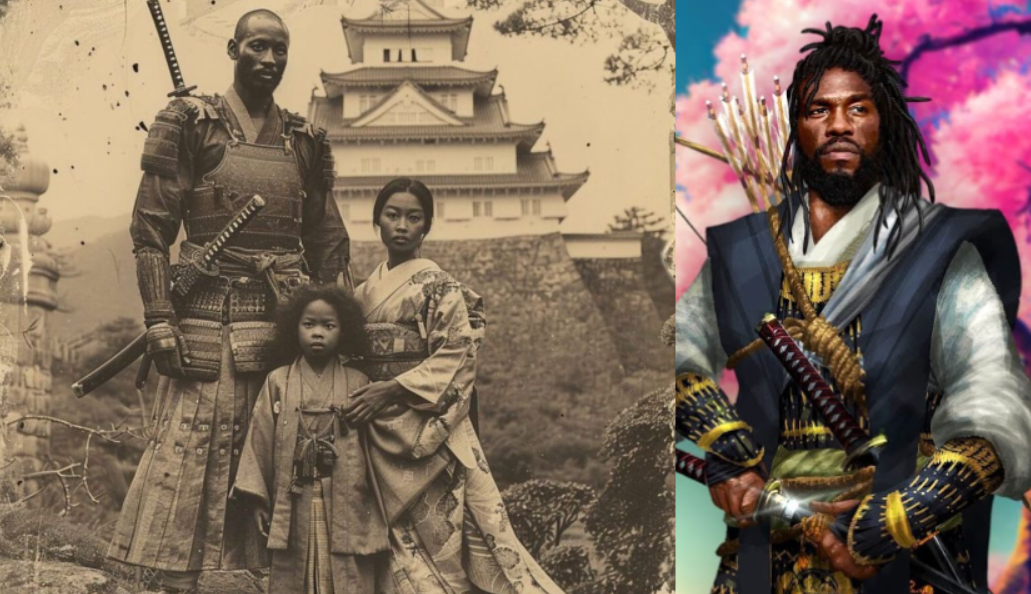Everyone knows about the Samurai, the class of elite warriors who defended Japan’s honour for hundreds of years. But few know about Yasuke, the mysterious man from Africa who became the first foreign-born samurai in the 16th century.
Recently, the awe-inspiring African warrior was unveiled as a character in the video game series Assassin’s Creed Shadows, raising a lot of questions about his origins and rise to prominence. In this article, we will answer some of those questions.
Yasuke’s Mysterious Beginnings
There is still a lot of obscurity surrounding Yasuke’s origins—even his original name is unknown. While some scholars posit that he was born in the East African country of Mozambique sometime in the mid-16th century, others trace his roots to other African countries like Nigeria or Ethiopia. However, there is a clear record that he landed in Japan in 1579, accompanying an Italian Jesuit missionary called Alessandro Valignano.
Valignano was charged with overseeing and fostering the growth of the Catholic missions in the Asian region in 1573. Subsequently, he spent a lot of time in then Portuguese India, Macau and Japan. So, what was his link to Yasuke?
Scholars believe Valignano must have met Yasuke during one of his voyages in Africa or India. Yasuke, towering at over six feet with an intimidating build, surely made a good fit for Valignano’s bodyguard. Since missionaries were not allowed to be armed at the time, Yasuke’s presence was enough protection.
Upon arriving in Japan, Yasuke’s dark skin and build quickly captivated the Japanese. Before then, only a few Africans had landed on Japan’s shores, so Yasuke was something of a spectacle. The locals flocked to the streets just to see him, causing stampedes that crushed people and buildings alike.
By 1581, tales of Yasuke’s immense strength and imposing presence had reached Oda Nobunaga, a feudal lord (daimyō) who was regarded as the first ‘Great Unifier of Japan’. Nobunaga summoned Yasuke to his court, marking the beginning of a relationship that would alter the course of Yasuke’s life.
The African Giant and the Japanese Feudal Lord
Interestingly, when Nobunaga met Yasuke, he examined Yasuke’s skin as he believed it to be painted black. The warlord commanded Yasuke to be washed, but the ebony tone of his skin remained unchanged.
More than anything though, Nobunaga was impressed by Yasuke’s physique, intelligence and demeanour. In fact, he was so taken with him that he threw a feast in Yasuke’s honour and soon recruited him as a samurai. Nobunaga also gave him a house, money and servants.
Yasuke’s appointment was no small feat as samurai were esteemed warriors, bound by the bushidō code of honour, loyalty, and martial prowess. Though Yasuke had already been a warrior beforehand, many believe he underwent a more rigorous training befitting of the samurai status. He went on to master the art of Japanese warfare and fought alongside Nobunaga in his campaigns to unify Japan.
Nobunaga’s violent peace campaigns were quite the paradox. ‘He would quite happily wipe out 10,000 people if he thought it would forward the aims of peace,’ narrated British historian Thomas Lockley in his book about Yasuke. Nobunaga’s plan was successful, until it wasn’t.
On 21 June 1582, one of the warlord’s trusted generals, Akechi Mitsuhide, ambushed him in Kyoto on the way to a battle. Mitsuhide had about 13,000 troops surround Nobunaga and his 30-something troops, including Yasuke. Nobunaga’s party stood sorely defeated, forcing Nobunaga, Yasuke and an attendant named Mori Ranmaru to retreat into one of Honnō-ji Temple’s chambers. There, Nobunaga performed seppuku, a ritual suicide that involved using a sword to slice open his abdomen. Ranmaru then beheaded him and committed his own seppuku too.
Yasuke was later captured by the enemy camp, but his life was spared since he wasn’t Japanese. However, some historians opine that Mitsuhide spared Yasuke so he could gain favour with the Jesuit missionaries.
Yasuke’s Legacy
Not much is known about Yasuke’s life post-Nobunaga. Some believe that he stayed in Japan as there were records of a tall African man in Japan in the 1590s. Others believe he went back to accompanying the Jesuits on their travels through Asia.
Still, Yasuke’s legacy endures, immortalised in Japanese folklore, literature and now, modern media. From manga adaptations to film portrayals, Yasuke continues to inspire a global audience. This African man from unknown whereabouts could rise to become part of the upper echelon of Japanese society, so maybe we can also forge our own paths in unfamiliar

Oyindamola Depo Oyedokun
Oyindamola Depo Oyedokun is an avid reader and lover of knowledge, of most kinds. When she's not reading random stuff on the internet, you'll find her putting pen to paper, or finger to keyboard.
follow me :
Leave a Comment
Sign in or become a Africa Rebirth. Unearthing Africa’s Past. Empowering Its Future member to join the conversation.
Just enter your email below to get a log in link.

